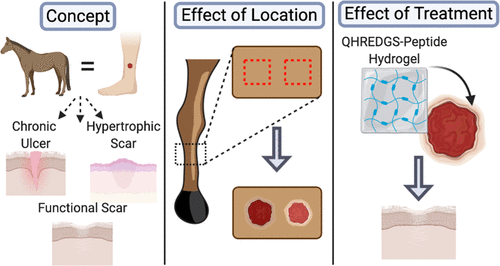当前位置:
X-MOL 学术
›
ACS Biomater. Sci. Eng.
›
论文详情
Our official English website, www.x-mol.net, welcomes your feedback! (Note: you will need to create a separate account there.)
Biomechanics of Wound Healing in an Equine Limb Model: Effect of Location and Treatment with a Peptide-Modified Collagen–Chitosan Hydrogel
ACS Biomaterials Science & Engineering ( IF 5.8 ) Pub Date : 2020-12-20 , DOI: 10.1021/acsbiomaterials.0c01431 Holly D. Sparks 1 , Taisiya Sigaeva 2, 3 , Samar Tarraf 4 , Serena Mandla 5, 6 , Hannah Pope 7 , Olivia Hee 7 , Elena S. Di Martino 3 , Jeff Biernaskie 7, 8, 9 , Milica Radisic 5, 6, 10 , W. Michael Scott 11
ACS Biomaterials Science & Engineering ( IF 5.8 ) Pub Date : 2020-12-20 , DOI: 10.1021/acsbiomaterials.0c01431 Holly D. Sparks 1 , Taisiya Sigaeva 2, 3 , Samar Tarraf 4 , Serena Mandla 5, 6 , Hannah Pope 7 , Olivia Hee 7 , Elena S. Di Martino 3 , Jeff Biernaskie 7, 8, 9 , Milica Radisic 5, 6, 10 , W. Michael Scott 11
Affiliation

|
The equine distal limb wound healing model, characterized by delayed re-epithelialization and a fibroproliferative response to wounding similar to that observed in humans, is a valuable tool for the study of biomaterials poised for translation into both the veterinary and human medical markets. In the current study, we developed a novel method of biaxial biomechanical testing to assess the functional outcomes of healed wounds in a modified equine model and discovered significant functional and structural differences in both unwounded and injured skin at different locations on the distal limb that must be considered when using this model in future work. Namely, the medial skin was thicker and displayed earlier collagen engagement, medial wounds experienced a greater proportion of wound contraction during closure, and proximal wounds produced significantly more exuberant granulation tissue. Using this new knowledge of the equine model of aberrant wound healing, we then investigated the effect of a peptide-modified collagen–chitosan hydrogel on wound healing. Here, we found that a single treatment with the QHREDGS (glutamine–histidine–arginine–glutamic acid–aspartic acid–glycine–serine) peptide-modified hydrogel (Q-peptide hydrogel) resulted in a higher rate of wound closure and was able to modulate the biomechanical function toward a more compliant healed tissue without observable negative effects. Thus, we conclude that the use of a Q-peptide hydrogel provides a safe and effective means of improving the rate and quality of wound healing in a large animal model.
中文翻译:

马肢模型中的伤口愈合的生物力学:肽修饰的胶原蛋白-壳聚糖水凝胶对位置和治疗的影响
马远端肢体伤口愈合模型的特点是延迟上皮再生和对伤口的纤维增生反应,类似于在人类中观察到的模型,是研究准备转化为兽用和人类医疗市场的生物材料的有价值的工具。在当前的研究中,我们开发了一种新的双轴生物力学测试方法,以评估改良的马模型中伤口愈合的功能结果,并发现在未受伤的皮肤和受伤的皮肤上,远端肢体上不同位置的显着功能和结构差异必须加以解决。在将来的工作中使用此模型时需要考虑的问题。就是说,内侧皮肤较厚并显示出较早的胶原蛋白结合,内侧伤口在闭合期间经历了更大比例的伤口收缩,而近端伤口产生明显更多的旺盛肉芽组织。利用异常伤口愈合的马模型的这一新知识,我们然后研究了肽修饰的胶原蛋白-壳聚糖水凝胶对伤口愈合的影响。在这里,我们发现用QHREDGS(谷氨酰胺-组氨酸-精氨酸-谷氨酸-天冬氨酸-甘氨酸-丝氨酸)肽修饰的水凝胶(Q肽水凝胶)进行单次治疗可提高伤口闭合率,并且能够调节生物力学功能,使其更顺应愈合的组织,而不会产生负面影响。因此,我们得出结论,在大型动物模型中,使用Q肽水凝胶可提供一种安全有效的手段来提高伤口愈合的速度和质量。利用异常伤口愈合的马模型的这一新知识,我们然后研究了肽修饰的胶原蛋白-壳聚糖水凝胶对伤口愈合的影响。在这里,我们发现用QHREDGS(谷氨酰胺-组氨酸-精氨酸-谷氨酸-天冬氨酸-甘氨酸-丝氨酸)肽修饰的水凝胶(Q肽水凝胶)进行单次治疗可提高伤口闭合率,并且能够调节生物力学功能,使其更顺应愈合的组织,而不会产生负面影响。因此,我们得出结论,在大型动物模型中,使用Q肽水凝胶可提供一种安全有效的方法来提高伤口愈合的速度和质量。利用异常伤口愈合的马模型的这一新知识,我们然后研究了肽修饰的胶原蛋白-壳聚糖水凝胶对伤口愈合的影响。在这里,我们发现用QHREDGS(谷氨酰胺-组氨酸-精氨酸-谷氨酸-天冬氨酸-甘氨酸-丝氨酸)肽修饰的水凝胶(Q肽水凝胶)进行单次治疗可提高伤口闭合率,并且能够调节生物力学功能,使其更顺应愈合的组织,而不会产生负面影响。因此,我们得出结论,在大型动物模型中,使用Q肽水凝胶可提供一种安全有效的手段来提高伤口愈合的速度和质量。我们发现,使用QHREDGS(谷氨酰胺-组氨酸-精氨酸-谷氨酸-天冬氨酸-甘氨酸-丝氨酸)肽修饰的水凝胶(Q肽水凝胶)进行单次治疗可提高伤口闭合率,并能够调节生物力学功能,可以使愈合的组织更加顺滑,而不会产生负面影响。因此,我们得出结论,在大型动物模型中,使用Q肽水凝胶可提供一种安全有效的手段来提高伤口愈合的速度和质量。我们发现,使用QHREDGS(谷氨酰胺-组氨酸-精氨酸-谷氨酸-天冬氨酸-甘氨酸-丝氨酸)肽修饰的水凝胶(Q肽水凝胶)进行单次治疗可提高伤口闭合率,并能够调节生物力学功能,可以使愈合的组织更加顺滑,而不会产生负面影响。因此,我们得出结论,在大型动物模型中,使用Q肽水凝胶可提供一种安全有效的手段来提高伤口愈合的速度和质量。
更新日期:2021-01-11
中文翻译:

马肢模型中的伤口愈合的生物力学:肽修饰的胶原蛋白-壳聚糖水凝胶对位置和治疗的影响
马远端肢体伤口愈合模型的特点是延迟上皮再生和对伤口的纤维增生反应,类似于在人类中观察到的模型,是研究准备转化为兽用和人类医疗市场的生物材料的有价值的工具。在当前的研究中,我们开发了一种新的双轴生物力学测试方法,以评估改良的马模型中伤口愈合的功能结果,并发现在未受伤的皮肤和受伤的皮肤上,远端肢体上不同位置的显着功能和结构差异必须加以解决。在将来的工作中使用此模型时需要考虑的问题。就是说,内侧皮肤较厚并显示出较早的胶原蛋白结合,内侧伤口在闭合期间经历了更大比例的伤口收缩,而近端伤口产生明显更多的旺盛肉芽组织。利用异常伤口愈合的马模型的这一新知识,我们然后研究了肽修饰的胶原蛋白-壳聚糖水凝胶对伤口愈合的影响。在这里,我们发现用QHREDGS(谷氨酰胺-组氨酸-精氨酸-谷氨酸-天冬氨酸-甘氨酸-丝氨酸)肽修饰的水凝胶(Q肽水凝胶)进行单次治疗可提高伤口闭合率,并且能够调节生物力学功能,使其更顺应愈合的组织,而不会产生负面影响。因此,我们得出结论,在大型动物模型中,使用Q肽水凝胶可提供一种安全有效的手段来提高伤口愈合的速度和质量。利用异常伤口愈合的马模型的这一新知识,我们然后研究了肽修饰的胶原蛋白-壳聚糖水凝胶对伤口愈合的影响。在这里,我们发现用QHREDGS(谷氨酰胺-组氨酸-精氨酸-谷氨酸-天冬氨酸-甘氨酸-丝氨酸)肽修饰的水凝胶(Q肽水凝胶)进行单次治疗可提高伤口闭合率,并且能够调节生物力学功能,使其更顺应愈合的组织,而不会产生负面影响。因此,我们得出结论,在大型动物模型中,使用Q肽水凝胶可提供一种安全有效的方法来提高伤口愈合的速度和质量。利用异常伤口愈合的马模型的这一新知识,我们然后研究了肽修饰的胶原蛋白-壳聚糖水凝胶对伤口愈合的影响。在这里,我们发现用QHREDGS(谷氨酰胺-组氨酸-精氨酸-谷氨酸-天冬氨酸-甘氨酸-丝氨酸)肽修饰的水凝胶(Q肽水凝胶)进行单次治疗可提高伤口闭合率,并且能够调节生物力学功能,使其更顺应愈合的组织,而不会产生负面影响。因此,我们得出结论,在大型动物模型中,使用Q肽水凝胶可提供一种安全有效的手段来提高伤口愈合的速度和质量。我们发现,使用QHREDGS(谷氨酰胺-组氨酸-精氨酸-谷氨酸-天冬氨酸-甘氨酸-丝氨酸)肽修饰的水凝胶(Q肽水凝胶)进行单次治疗可提高伤口闭合率,并能够调节生物力学功能,可以使愈合的组织更加顺滑,而不会产生负面影响。因此,我们得出结论,在大型动物模型中,使用Q肽水凝胶可提供一种安全有效的手段来提高伤口愈合的速度和质量。我们发现,使用QHREDGS(谷氨酰胺-组氨酸-精氨酸-谷氨酸-天冬氨酸-甘氨酸-丝氨酸)肽修饰的水凝胶(Q肽水凝胶)进行单次治疗可提高伤口闭合率,并能够调节生物力学功能,可以使愈合的组织更加顺滑,而不会产生负面影响。因此,我们得出结论,在大型动物模型中,使用Q肽水凝胶可提供一种安全有效的手段来提高伤口愈合的速度和质量。


























 京公网安备 11010802027423号
京公网安备 11010802027423号